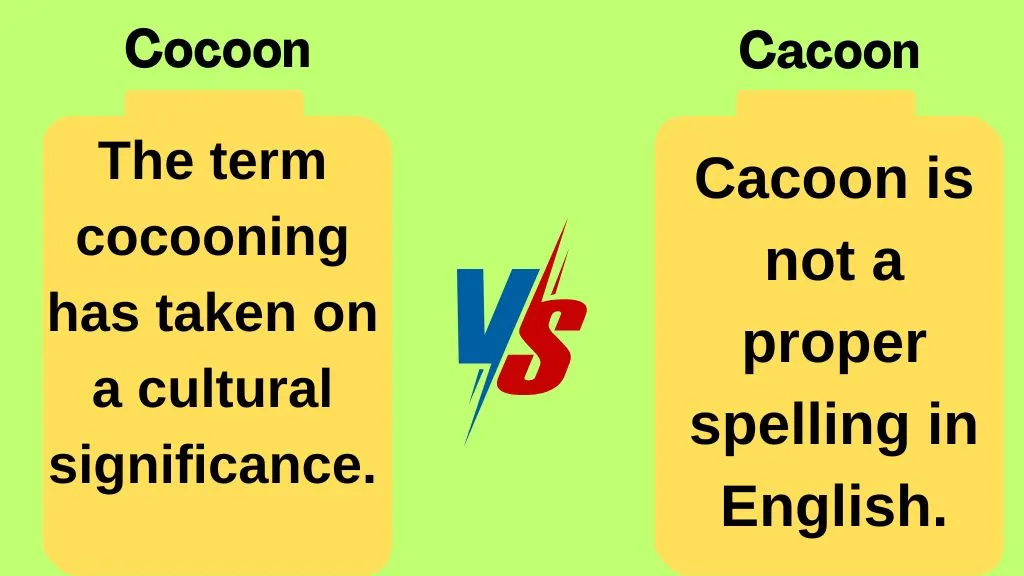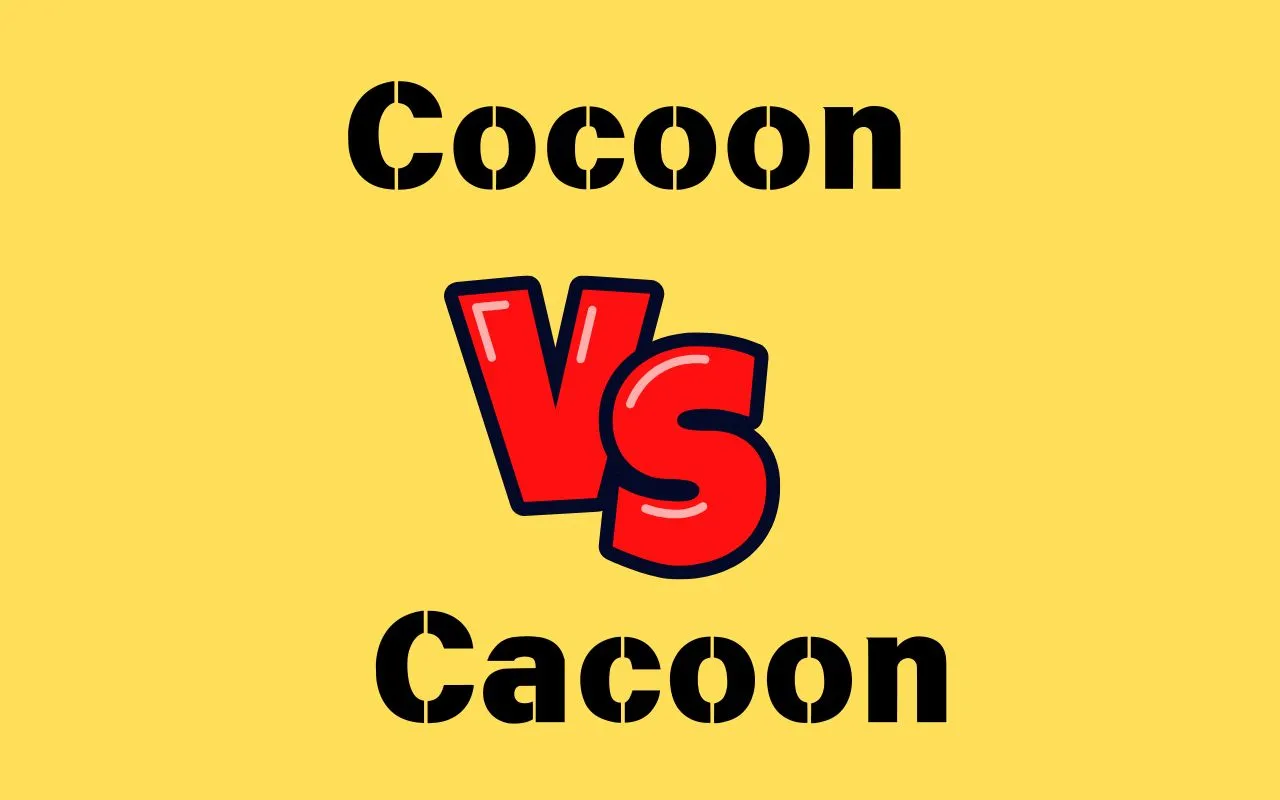Last updated on September 4th, 2025 at 07:16 am
English can often throw us curveballs, especially when words sound similar but have completely different meanings—or in this case, one word isn’t correct at all.
If you’ve ever paused to wonder whether to write cacoon or cocoon, this guide will clear things up for you. Spoiler alert: Cocoon is the correct spelling!
Is it cocoon or cacoon? Discover the correct spelling, the fascinating world of cocoons, and why cacoon might mean something entirely different!
Let’s dive into the fascinating world of cocoons, their meaning, and why this tiny silk casing plays such a big role in nature—and even in our everyday language.
Understanding the Fundamentals: Cocoon Defined
A cocoon is a protective covering spun by certain insects, like silkworms or moth larvae, to shield themselves during metamorphosis.
This silk casing serves as a shelter where the transformation into an adult insect occurs. While often associated with butterflies, cocoons are specifically made by moths and other insects—not butterflies, which form a chrysalis instead.
In a broader sense, the word cocoon has also been adopted into modern language to mean any snug or protective enclosure. For instance, you might hear phrases like “wrapped in a cocoon of blankets” to describe comfort and safety.
Key Characteristics of a Cocoon:
- Made of silk or other materials spun by an insect.
- Functions as a protective covering.
- Used during the pupal stage of some insects’ life cycles.
Quick Fact: What About Cacoon?
The word cacoon is not a proper spelling in English. It’s often a typo or mispronunciation of cocoon. However, it has a completely unrelated meaning, which we’ll cover later.
From Larva to Butterfly: The Role of a Cocoon
Cocoons play a critical role in the metamorphosis process for certain insects. They offer a secure environment where the larva can undergo the incredible transformation into its adult form.
Here’s how it works:
- The Larva Spins the Cocoon: Using silk secreted from glands, the larva creates a protective shell.
- Inside the Cocoon: Within this protective covering, the larva enters the pupal stage. During this time, the insect undergoes remarkable physical changes.
- Emergence as an Adult: After its transformation, the insect breaks free from the cocoon, fully grown and ready to live its adult life.
While butterflies also experience metamorphosis, they form a chrysalis—a hard shell-like covering that’s different from a cocoon. This distinction is essential to understanding the insect lifecycle.
The Lifecycle of a Butterfly: A Journey Through Phases
To fully grasp the role of a cocoon, it’s helpful to understand the butterfly lifecycle. Although butterflies don’t spin cocoons, they share many similarities with insects that do. The butterfly’s metamorphosis occurs in four stages:
- Egg: A butterfly lays tiny eggs on leaves or stems.
- Larva (Caterpillar): After hatching, the larva feeds on plant material to grow rapidly.
- Pupa (Chrysalis): The caterpillar forms a chrysalis where it transforms into an adult.
- Adult Butterfly: The butterfly emerges, ready to pollinate and reproduce.
Key Difference: While moths and some other insects spin cocoons, butterflies encase themselves in a chrysalis during the pupal stage. This is why the terms cocoon and chrysalis shouldn’t be used interchangeably.
Why a Cocoon Is Not a Chrysalis: Clarifying Common Misconceptions
It’s easy to confuse a cocoon with a chrysalis, but these terms describe two different structures.
| Feature | Cocoon | Chrysalis |
|---|---|---|
| Material | Silk spun by the larva | Hardened exoskeleton |
| Insects | Moths and other non-butterfly species | Butterflies |
| Appearance | Soft, silk-like covering | Smooth, shell-like, often camouflaged |
Takeaway: If you’re describing the protective covering of a butterfly, the correct term is chrysalis. Save cocoon for moths and similar insects.
Exploring ‘Cocoon’ in Action: Usage as a Verb
The word cocoon isn’t just a noun—it’s also a verb. When used this way, it means to wrap or envelop something in a protective or comforting way. This metaphorical use has become increasingly popular in modern English.
Examples of Cocoon as a Verb:
- “She cocooned herself in a warm blanket on a cold night.”
- “The child was cocooned in his mother’s arms, feeling safe and loved.”
This usage reflects the idea of protection, drawing inspiration from the insect world.
Cocooning for Comfort: More Than a Natural Phenomenon

In recent years, the term cocooning has taken on a cultural significance. It describes the act of staying indoors, away from the outside world, to focus on personal comfort and relaxation.
Examples of Cocooning:
- Watching movies under a pile of blankets on a rainy day.
- Spending a weekend at home indulging in self-care and cozy activities.
Cocooning became especially relevant during the pandemic, as people sought comfort and security within their homes.
The Other Cacoon: Not a Typo, a Tropical Bean
Interestingly, cacoon is not just a misspelling of cocoon. It’s also the name of a tropical plant, Entada rheedii, commonly known as the cacoon bean. This plant produces large seeds often used in traditional medicine or as jewelry.
Quick Facts About the Cacoon Bean:
- Scientific Name: Entada rheedii
- Uses: Medicinal purposes, crafting ornaments, or as flotation devices.
- Region: Found in tropical areas like Africa and Asia.
While it’s unrelated to cocoons spun by insects, the shared spelling can cause confusion.
Unraveling the Synonyms: Similar Terms for Cocoon
The English language is rich with synonyms and related terms that can add nuance to your writing.
Synonyms for Cocoon:
- Covering: A general term for anything that protects or encases.
- Pupa Case: Specifically refers to the protective casing of an insect in the pupal stage.
- Shelter: Often used metaphorically, much like cocoon.
Each synonym can add variety to your writing while retaining the same core idea.
Choosing the Right Word: When to Use Pupa, Pod, or Covering
Selecting the right word depends on context. Here’s a guide to help you choose:
| Term | When to Use |
|---|---|
| Pupa | Refers to the developmental stage within the cocoon. |
| Pod | Describes a protective case, often for seeds or plants. |
| Covering | A broad term for any protective or enclosing layer. |
Verb Variants: Swaddle, Wrap, and Protect
The verb cocoon has several close relatives in meaning, such as:
- Swaddle: Commonly used to describe wrapping a baby snugly.
- Wrap: A general term for enclosing something in layers.
- Protect: Emphasizes the act of safeguarding something.
Each of these verbs can be used interchangeably with cocoon in the right context.
Embracing Etymology: Cocoon’s Linguistic Origins and Evolution
The word cocoon traces its roots to the French term cocon, which means “shell.” This, in turn, originated from the Latin word coccum, meaning “berry” or “seed.” The term eventually evolved to describe the silk cases created by larvae.
Key Insight: The connection to seeds and shells highlights the protective, enclosing nature of a cocoon.
FAQs
Which is correct: cocoon or cacoon?
The correct spelling is “cocoon.” “Cacoon” is a common misspelling or typo, though it also refers to a tropical bean in rare contexts.
What is the purpose of a cocoon?
A cocoon is a protective covering spun by certain insects, such as moth larvae, to shield themselves during metamorphosis.
Do butterflies use cocoons?
No, butterflies form a chrysalis, which is a hardened exoskeleton. Cocoons are specific to moths and some other insects.
What does cocoon mean in modern language?
In everyday usage, cocoon refers to wrapping or enveloping something in a protective or comforting way, such as “cocooning” at home.
What is the cacoon bean?
The cacoon bean, or Entada rheedii, is a tropical plant used in traditional medicine and ornament crafting, unrelated to insect cocoons.
Final Thoughts
Understanding the difference between cocoon and cacoon may seem small, but it’s a great example of why language matters.
Whether you’re discussing insect metamorphosis or using cocoon as a metaphor, precision in language elevates your communication.
So, the next time you encounter these words, remember: Cocoon refers to a silk enclosure or a metaphorical sense of comfort. Cacoon, meanwhile, might be a fascinating tropical bean—but never a substitute for the correct spelling
